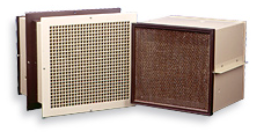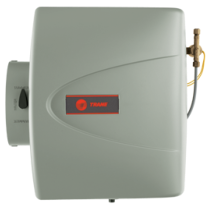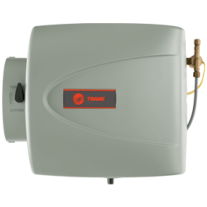Humidifiers

Aprilaire Model 800 Residential Steam Humidifier

The humidifier that is not dependant on your HVAC system to provide humidity to the largest of homes: the Model 800.
The Aprilaire Model 800 Residential Steam Humidifier features truly automatic control, so there’s no need to manually control the humidifier – though it can be installed in manual mode, if desired.
Complementing none-forced air heating sources and other specialty heating systems:
- Has a capacity of 11.5, 20.5 or 23.3 gallons per day depending on electrical draw.
- Humidifies tightly-constructed homes up to 6,200 ft2

Aprilaire Model 700 Whole-House Humidifier


Big humidification performance to match the biggest homes: the Model 700.
The Aprilaire Model 700 Whole-House Humidifier features truly automatic control, so there’s never a need to manually control the humidifier—though it can be installed in manual mode, if desired.
Complementing any central heating and cooling system, the Aprilaire Model 700 Whole-House Humidifier:
- Utilizes an outdoor temperature sensor for monitoring even the slightest changes in outdoor temperature
- Delivers up to 50% more moisture in comparison to competitive units
- Has an evaporation capacity of 0.75 gallons per hour—among the highest capacity humidifiers sold
- Humidifies tightly-constructed homes up to 4,200 square feet in size

Aprilaire Model 600 Whole-House Humidifier


Want the perfect humidity level for any season? Take a look at the Model 600.
The Aprilaire Model 600 Whole-House Humidifier features truly automatic control, plus a built-in bypass damper, which means fewer parts to install. The bypass damper is conveniently labeled for both summer and winter settings, allowing you to set it for the entire season with no guesswork involved. The Aprilaire Model 600 Whole-House Humidifier is simply the best performing bypass humidifier on the market.
The Aprilaire Model 600 Whole-House Humidifier:
- Features the same performance benefits of other Aprilaire Humidifiers
- Delivers up to 50% more moisture in comparison to competitive units
- Has an evaporation capacity of 0.70 gallons per hour
- Humidifies tightly-constructed homes up to 4,000 square feet in size

Aprilaire Model 500 Whole-House Humidifier


Get big results for small to mid-size homes with the Model 500 Whole-Home Humidifier.
The Aprilaire Model 500 Whole-House Humidifier features a built-in bypass damper and is designed for use in small to mid-size homes with automatic digital control for premium performance and convenience.
The Aprilaire Model 500 Whole-House Humidifier:
- Installed in central heating and cooling system ductwork.
- Comes equipped with a drain to flush minerals from the unit
- Has an evaporation capacity of 0.50 gallons per hour
- Humidifies tightly-constructed homes up to 3,000 square feet in size

Aprilaire Model 400 Whole-House Humidifier


Need to maximize your humidity control with minimal water? Choose the Model 400 with automatic digital control.
The Aprilaire Model 400 Whole-House Humidifier features a built-in bypass damper and utilizes new evaporative technology to minimize water use. Gravity pulls water down, while the wicking action of the Water Panel ® draws it back to the top, using 100% of the water delivered to the unit.
The Aprilaire Model 400 Whole-House Humidifier:
- Features truly automatic control
- Eliminates standing water, making it the perfect choice for homes with septic systems, locations where a floor drain is not available or families interested in water conservation
- Has an evaporation capacity of 0.70 gallons per hour
- Humidifies tightly-constructed homes up to a 4,000 square foot in size

Aprilaire Models 350/360 Whole-House Humidifiers

Want state-of-the-art humidification for your radiator/baseboard heating system? Look no further.
The Aprilaire Models 350/360 Whole-House Humidifiers are specifically designed to bring all the benefits of patented Aprilaire humidification to homes with radiators or baseboard heat. The Models 350/360 are so effective and flexible, they work equally well with central heating and cooling systems.
The Aprilaire Models 350/360 Whole-House Humidifiers:
- Are completely self-contained units
- Easily fit inside of closets, heated crawl spaces and basements
- Have an evaporative capacity of 0.50 gallons per hour
- Humidify tightly-constructed homes up to 4,500 square feet in size
THUMD500 Humidifier

Temperature is just one factor in total home comfort, especially in dry weather. A Trane humidifier provides the right amount of moisture in every room, and can help alleviate allergy symptoms.
- Fan-powered whole-house humidifier
- For homes up to 4,200 square feet
- Up to 18 gallons per day output
Moisturizing Air
Trane’s trusted humidifiers can adjust from summer to winter to provide the right amount of moisture to the air in your home. It’s not just comfort. It’s relief for your skin.
Dry Home Protection
Having a dry home can be damaging to valuable things such as furniture, paintings and woodwork. By adding a Trane humidifier to your home’s heating and cooling system, you can help ensure it won’t dry and crack.
Better, cleaner air
When paired with Trane CleanEffects™ technology, a Trane humidifier will not only alleviate the dryness but also give you the most advanced whole-house air filtration system. So you get clean, comfortable air that feels good all year long.
THUMD300 Humidifier

Temperature is just one factor in total home comfort, especially in dry weather. A Trane humidifier provides the right amount of moisture in every room, and can help alleviate allergy symptoms.
- Whole-house humidifier for larger homes
- For homes up to 4,000 square feet
- Up to 17 gallons per day output
Moisturizing Air
Trane’s trusted humidifiers can adjust from summer to winter to provide the right amount of moisture to the air in your home. It’s not just comfort. It’s relief for your skin.
Dry Home Protection
Having a dry home can be damaging to valuable things such as furniture, paintings and woodwork. By adding a Trane humidifier to your home’s heating and cooling system, you can help ensure it won’t dry and crack.
Better, cleaner air
When paired with Trane CleanEffects™ technology, a Trane humidifier will not only alleviate the dryness but also give you the most advanced whole-house air filtration system. So you get clean, comfortable air that feels good all year long.
THUMD200 Humidifier

Temperature is just one factor in total home comfort, especially in dry weather. A Trane humidifier provides the right amount of moisture in every room, and can help alleviate allergy symptoms.
- Whole-house humidifier for standard homes
- For homes up to 3,000 square feet
- Up to 12 gallons per day output
Moisturizing Air
Trane’s trusted humidifiers can adjust from summer to winter to provide the right amount of moisture to the air in your home. It’s not just comfort. It’s relief for your skin.
Dry Home Protection
Having a dry home can be damaging to valuable things such as furniture, paintings and woodwork. By adding a Trane humidifier to your home’s heating and cooling system, you can help ensure it won’t dry and crack.
Better, cleaner air
When paired with Trane CleanEffects™ technology, a Trane humidifier will not only alleviate the dryness but also give you the most advanced whole-house air filtration system. So you get clean, comfortable air that feels good all year long.

Performance Fan Humidifier
Models: HUMCCLFP, HUMCCSFP

Fan-Powered Humidifier Keeps Home Comfortable All Year
The Performance Fan Humidifier blows moisture vapor directly into your ducts. This home humidifier was engineered to work with Carrier products for improved whole house comfort. Avoid static electricity shocks and enjoy optimum humidity levels year-round.
Key Features
Self-powered fan
Front access door
Low-noise operation
Attractive, long-lasting, cover
Optimum moisture distribution
Small or large capacity models available
Humidistat, Humiditrac™, Thermidistat™ and Infinity control options
5-year limited warranty on parts
Ratings
Moisture Control
Quiet Level
Energy Efficiency

Performance Bypass Humidifier
Models: HUMCCLBP, HUMCCSBP, HUMCCWBP

Whole House Moisture-Control That Works with Your Furnace
The Performance Bypass Humidifier uses less power by letting your furnace blower drive moisture vapor into your ducts. This house humidifier lets you set and keep moisture levels comfortable with smart control options.
Key Features
Front access door
Low-noise operation
Attractive, long-lasting, cover
Optimum moisture distribution
Small or large capacity models available
Humidistat, Humiditrac™ and Thermidistat™ control options
5-year limited warranty on parts
Ratings
Moisture Control
Quiet Level
Energy Efficiency
TrueSTEAM™ Humidification System

Model Numbers:
HM506W1005, HM509W1005, HM512W1005, HM512WTHX9, HM512VPIAQ, HM512DG115, HM509VPIAQ, HM509DG115, HM509H8908, HM506VPIAQ, HM506DG115, HM506H8908, HM, HM506, HM509, HM512
5-Year Warranty
- Delivers up to 12 gallons of moisture into the air each day
- For homes up to 3,000 square feet
- Uses significantly less water than other whole-house humidifiers
Moisture on Demand
TrueSTEAM works by producing its own steam independent of equipment operation, so your home gets moisture when you need it most.
Eco-Friendly
TrueSTEAM is the most eco-friendly way to humidify your home, because for every 1 gallon of water used, 1 gallon of humidification is produced.
“True Steam”
While other humidifiers rely on moisture-filled pads that can be susceptible to bacteria growth in the water and the airstream, TrueSTEAM delivers “true steam” – the cleanest form of humidification.
Out of Sight, Out of Mind
TrueSTEAM is installed out-of-sight by your heating and cooling professional into your home’s central heating and cooling system. You can forget about having to fill clunky, portable units, because TrueSTEAM automatically fills itself.
Whole-House Solution
Installs directly or remotely to your furnace to deliver moisture throughout your entire home.
Minimal Maintenance
Simply clean once a year with soap and water and the rest of the time it cleans itself automatically.
TrueEASE™ Evaporative Humidifiers

Model Numbers:
HE100, HE200, HE150, HE250, HE300
5-Year Warranty
- Installs with central hvac systems to deliver whole-home comfort
- Eliminates maintenance hassles with easy-access pads
- Saves energy by eliminating constant cycling of air
Whole-Home Comfort for All
The versatile design of TrueEASE humidifiers allows for installation in every home, including townhomes and codos where it once was impossible.
Eco-Friendly
TrueEASE says goodbye waste and hello efficiency by automatically monitoring the dryness in your home, and only running water and air through the system when humidity is needed – saving up to 10,000 (model and system dependent) gallons of water per year.
Reduced Heating Bills
In addition to keeping your home and family comfortable, TrueEASE can help reduce heating bills. Because humidified air feels warmer, you’ll be able to turn your thermostat down for energy savings.
Out of Sight, Out of Mind
TrueSTEAM is installed out-of-sight by your heating and cooling professional into your home’s central heating and cooling system. You can forget about having to fill clunky, portable units, because TrueSTEAM automatically fills itself.
Simple Maintenance
User-friendly pad access makes mainteneance and upkeep easier than ever, which leads to sustained, long-term comfort
HE225/265 Bypass Humidifier

Model Numbers:
HE265VPIAQ, HE265DG115, HE265H8908, HE225VPIAQ, HE225DG115, HE225H8908
5-Year Warranty
- Delivers up to 17 gallons of moisture into the air each day
- Simple humidifier pad replacement
- Seasonal damper allows for control of humidity from season to season
High Output
Delivers up to 17 gallons of moisture into the home each day
Seasonal Damper
Allows for easy control of humidity from season to season
Simple Maintenance
Replacement Honeywell Humidifier pads can be purchased from and/or replaced by your heating and cooling contractor, and also fit Aprilaire Humidifiers
Exlusive AgION Humidifier Pads
Feature an anti-microbial coating which helps inhibit the growth of molds, bacteria, fungus and algae on the pads
PerfectFLO Distribution Tray
Helps ensure that moisture is distributed evently
